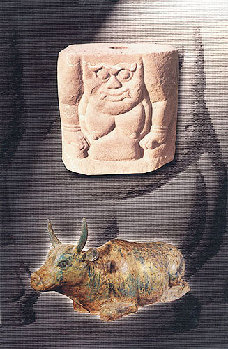Mausoleums of kings as well as other attendant tombs, Western Xia Dynasty (1038-1227)
Location: Yinchuan, Ningxia Hui Autonomous Region
Period: 1,038-1,277
Excavated from 1972 to the present
Significance: It has supplied full material objects to the study of the political, economic, cultural developments, as well as the burial systems of the Western Xia Dynasty.
|

|
| Statue of human: pedestal of stele (up, height 60 cm); Bronze ox: burial accessory (bottom, length 120 cm) |
 Introduction
Introduction
The mausoleums of the ancient kingdom of Western Xia kings are reputed to be the "Pyramids in the Orient". The kings were buried in nine mausoleums on the eastern side of the Helan Mountain. Forming a complete architectural group together with these mausoleums over an area of 40 square kilometers are also tombs of more than 70 high officials, generals and aristocrats, ruins of a Buddhist temple, and a dozen or so brick and tile kilns dating back to the Western Xia period. This is one of the largest and best-preserved imperial graveyards in China.
The Western Xia mausoleums are unique not only in structure but also in their sheer sizes and close proximity to each other. A seven-layered solid pagoda of 22 meters in height and octagonal in shape, with each side measuring 12 meters in length, is positioned 10 meters west of the vertical line of each mausoleum, which is also graced with two to three stele pavilions. The boundaries of each mausoleum are marked with four corner turrets, a unique feature of Western Xia mausoleums. The companion tombs are in cylindrical, truncated cones, vaulted and other designs.
The Western Xia was once a valiant kingdom covering the whole Ningxia, most ofGansuand parts ofQinghai,Inner MongoliaandShaanxi. It had created unique and brilliant culture, which was recorded in the travel notes of Marco Polo, who praised the camel haircloth produced there as "the most beautiful" in the world.
Unearthed objects include three pedestals of stone tablets, a fragment of a stone tablet bearing Western Xia scripts, bricks engraved with patterns, and some porcelain shards, coins, bronze objects, iron tools, and architectural decorations.
